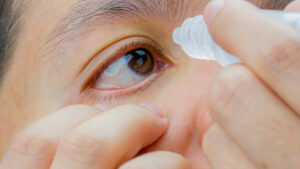January 1, 2024
By Huy Tran, MD, PhD, and Thi D. Duong, BOptom

Photo Credit: Artinun Prekmoung, Dreamstime
While myopia control treatment has been successfully adopted worldwide,1 delaying the onset of myopia is an emerging option to contribute to preventing higher levels of myopia and its related complications.2
This randomized clinical trial investigated the efficacy and safety of low-concentration atropine in preventing the development of myopia. Over two years, a total of 474 eligible Chinese pre-myopic children (50% females), aged between 4 and 9 years, were randomly assigned to have either 0.05% atropine, 0.01% atropine, or placebo eye drops once nightly. The primary outcomes, including the two-year cumulative incidence of myopia and the percentage of fast myopic shift, were collected, in addition to the common side effects of topical atropine with pupillary dilation, reduction of accommodative amplitude, and visual acuity in all the groups.
The results highlighted the significantly greater two-year cumulative incidence of myopia and the percentage of participants with fast myopic shift in the 0.01% atropine group and placebo group. Differences of between 20% and 30% compared to that observed in the group using 0.05% atropine were found. However, no differences were observed between the group with 0.01% atropine and the placebo group. In addition, the most commonly reported adverse event was photophobia, but the percentages were clinically irrelevant between groups.
This randomized clinical trial concluded that 0.05% atropine has a role in delaying the onset of myopia and reducing the fast pace of myopic shift in Asian children. However, more evidence is warranted to provide the longer-term safety of this potential treatment option.
Abstract
Effect of Low-Concentration Atropine Eyedrops vs Placebo on Myopia Incidence in Children: The LAMP2 Randomized Clinical Trial
Jason C. Yam, MPH; Xiu Juan Zhang, PhD; Yuzhou Zhang, PhD; Benjamin H. K. Yip, PhD; Fangyao Tang, PhD; Emily S. Wong, MBChB; Christine H. T. Bui, PhD; Ka Wai Kam, MSc; Mandy P. H. Ng, MHM; Simon T. Ko, MBBS; Wilson W.K. Yip, MBChB; Alvin L. Young, MMedSc; Clement C. Tham, BM, BCh; Li Jia Chen, PhD; Chi Pui Pang, Dphil.
Importance: Early onset of myopia is associated with high myopia later in life, and myopia is irreversible once developed.
Objective: To evaluate the efficacy of low-concentration atropine eye drops at 0.05% and 0.01% concentration for delaying the onset of myopia.
Design, Setting, and Participants: This randomized, placebo-controlled, double-masked trial conducted at the Chinese University of Hong Kong Eye Centre enrolled 474 nonmyopic children aged 4 through 9 years with cycloplegic spherical equivalent between +1.00 D to 0.00 D and astigmatism less than −1.00 D. The first recruited participant started treatment on July 11, 2017, and the last participant was enrolled on June 4, 2020; the date of the final follow-up session was June 4, 2022.
Interventions: Participants were assigned at random to the 0.05% atropine (n = 160), 0.01% atropine (n = 159), and placebo (n = 155) groups and had eyedrops applied once nightly in both eyes over 2 years.
Main Outcomes and Measures: The primary outcomes were the 2-year cumulative incidence rate of myopia (cycloplegic spherical equivalent of at least −0.50 D in either eye) and the percentage of participants with fast myopic shift (spherical equivalent myopic shift of at least 1.00 D).
Results: Of the 474 randomized patients (mean age, 6.8 years; 50% female), 353 (74.5%) completed the trial. The 2-year cumulative incidence of myopia in the 0.05% atropine, 0.01% atropine, and placebo groups were 28.4% (33/116), 45.9% (56/122), and 53.0% (61/115), respectively, and the percentages of participants with fast myopic shift at 2 years were 25.0%, 45.1%, and 53.9%. Compared with the placebo group, the 0.05% atropine group had significantly lower 2-year cumulative myopia incidence (difference, 24.6% [95% CI, 12.0%-36.4%]) and percentage of patients with fast myopic shift (difference, 28.9% [95% CI, 16.5%- 40.5%]). Compared with the 0.01% atropine group, the 0.05% atropine group had significantly lower 2-year cumulative myopia incidence (difference, 17.5% [95% CI, 5.2%-29.2%]) and percentage of patients with fast myopic shift (difference, 20.1% [95% CI, 8.0%-31.6%]). The 0.01% atropine and placebo groups were not significantly different in 2-year cumulative myopia incidence or percentage of patients with fast myopic shift. Photophobia was the most common adverse event and was reported by 12.9% of participants in the 0.05% atropine group, 18.9% in the 0.01% atropine group, and 12.2% in the placebo group in the second year.
Conclusions and Relevance: Among children aged 4 to 9 years without myopia, nightly use of 0.05% atropine eyedrops compared with placebo resulted in a significantly lower incidence of myopia and lower percentage of participants with fast myopic shift at 2 years. There was no significant difference between 0.01% atropine and placebo. Further research is needed to replicate the findings, to understand whether this represents a delay or prevention of myopia, and to assess longer-term safety.
Trial Registration: Chinese Clinical Trial Registry: ChiCTR-IPR-15006883
Yam, J. C., Zhang, X. J., Zhang, Y., Yip, B. H., Tang, F., Wong, E. S., … & Pang, C. P. (2023). Effect of low-concentration atropine eyedrops vs placebo on myopia incidence in children: the LAMP2 randomized clinical trial. JAMA, 329(6), 472-481.
DOI: https://doi.org/10.1001/jama.2022.24162
 |
Huy Tran, MD, PhD, is the Head of the Myopia Control Clinic at Hai Yen Eye Care and a lecturer at the University of Medicine and Pharmacy at Ho Chi Minh City, Vietnam. He also collaborates with BHVI on myopia-related projects. |
 |
Thi D. Duong, BOptom, is a clinical optometrist at the Myopia Control Clinic of Hai Yen Eye Care, working on myopia control projects and developing the myopia program in Ho Chi Minh City, Vietnam. |
References
- Lawrenson JG, Shah R, Huntjens B, et al. Interventions for myopia control in children: a living systematic review and network meta‐analysis. Cochrane Database of Systematic Reviews. 2023;(2)
- Haarman AE, Enthoven CA, Tideman JWL, Tedja MS, Verhoeven VJ, Klaver CC. The complications of myopia: a review and meta-analysis. Investigative ophthalmology & visual science. 2020;61(4):49-49.













